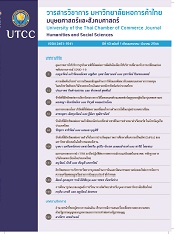Relationship between Research and Development Disclosure and Stock Return of Listed Companies in the Stock Exchange of Thailand.
Main Article Content
Abstract
This research aims to study the relationship between research and development disclosure and the stock return of listed companies on the Stock Exchange of Thailand. This study collects data from annual reports of the selected 564 companies from the first quarter of 2017 to the fourth quarter of 2020, totalling 16 quarters. The data were analysed using descriptive statistics and multiple regression analysis by fixed effect regression model (FEM). The results reveal that research and development disclosures were significantly related to stock return in the periods of six months or more; research disclosures were positive and development disclosures were negative, respectively.
Article Details

This work is licensed under a Creative Commons Attribution-NonCommercial-NoDerivatives 4.0 International License.
ลิขสิทธิ์ของบทความ
ผลงานที่ได้รับการตีพิมพ์ถือเป็นลิขสิทธิ์ของมหาวิทยาลัยหอการค้าไทย ห้ามมิให้นำเนื้อหา ทัศนะ หรือข้อคิดเห็นใด ๆ ของผลงานไปทำซ้ำ ดัดแปลง หรือเผยแพร่ ไม่ว่าทั้งหมดหรือบางส่วนโดยไม่ได้รับอนุญาตเป็นลายลักษณ์อักษรจากมหาวิทยาลัยหอการค้าไทยก่อน
References
กัลยา วานิชย์บัญชา. (2550). การวิเคราะห์สถิติ: สถิติสำหรับบริหารและวิจัย (พิมพ์ครั้งที่ 10). กรุงเทพฯ: โรงพิมพ์จุฬาลงกรณ์มหาวิทยาลัย.
ประกาศสภาวิชาชีพบัญชีที่ 50/2561 เรื่อง มาตรฐานการบัญชี ฉบับที่ 38 (ปรับปรุง 2561) เรื่อง สินทรัพย์ไม่มีตัวตน. (2561). สืบค้นเมื่อ 19 กุมภาพันธ์ 2565, จาก https://www.tfac.or.th/upload/9414/BL3QC4QdeH.PDF
ประภัสสร โปร่งวิทยากร, สุรางค์ เห็นสว่าง, และธนาวัฒน์ สิริวัฒน์ธนกุล. (2560). บทบาทของคณะกรรมการต่อผลการดำเนินงานด้านการเงินของบริษัทจดทะเบียนในตลาดหลักทรัพย์แห่งประเทศไทย. วารสารรัชต์ภาค, 11(23), 87-102.
เพชรี ขุมทรัพย์. (2544). หลักการลงทุน (พิมพ์ครั้งที่ 12). กรุงเทพฯ. มหาวิทยาลัยธรรมศาสตร์.
มนตรี พิริยะกุล. (2560). Panel data analysis. วารสารรามคำแหง สาขาวิทยาศาสตร์และเทคโนโลยี, 30(2), 41-54.
วิกรม มโนหมั่นศรัทธา (2558). ความสัมพันธ์ระหว่างคุณลักษณะของบริษัทกับการเปิดเผยข้อมูลด้านการวิจัยและพัฒนา: กรณีศึกษาบริษัทจดทะเบียนในตลาดหลักทรัพย์แห่งประเทศไทย (วิทยานิพนธ์ปริญญามหาบัณฑิต, มหาวิทยาลัยธรรมศาสตร์). สืบค้นจาก http://ethesisarchive.library.tu.ac.th/thesis/2015/TU_2015_5702110023_4036_2085.pdf
วีระวรรณ ศิริพงษ์, นิตินันท์ พราหมหันต์, ปนัดฐา พิมพกาญจน์, จิราภรณ์ ปัญญายิ่ง, สุชาวดี แสงศร อิศรา มาลาวัยจันทร์, และ มัทนชัย สุทธิพันธ์. (2562). ความสัมพันธ์ระหว่างการเปิดเผยข้อมูลการวิจัยและพัฒนาและผลการดำเนินงานทางการเงินของบริษัทจดทะเบียนในตลาดหลักทรัพย์แห่งประเทศไทย. วารสารบริหารธุรกิจเทคโนโลยีมหานคร, 16(2), 173-190.
ศิลปพร ศรีจันเพชร. (2551). ทฤษฎีบรรษัทภิบาล. วารสารบริหารธุรกิจ, 31(120), 1-4.
สำนักงานคณะกรรมการนโยบายวิทยาศาสตร์ เทคโนโลยีและนวัตกรรมแห่งชาติ. (2561). ข่าวประชาสัมพันธ์: สวทน. เผยตัวเลขลงทุนวิจัยและพัฒนาภาคเอกชน พุ่ง 39% คาดสิ้นปี 64 รัฐ-เอกชน ลงทุนทะลุ 180,000 ล้านบาท. สืบค้นเมื่อ 18 กุมภาพันธ์ 2565, จาก http://www.sti.or.th/sti/news-detail.php?news_type=2&news_id=304&
อิศรา มาลาวัยจันทร์, และกุลวดี ลิ่มอุสันโน. (2563). ความสัมพันธ์ระหว่างการเปิดเผยข้อมูลการวิจัยและพัฒนาและผลการดำเนินงานทางการเงิน กรณีศึกษาบริษัทจดทะเบียนในตลาดหลักทรัพย์ เอ็ม เอ ไอ. ใน การประชุมวิชาการระดับชาติด้านการบริหารจัดการ ครั้งที่ 12 (น. 90-102). สงขลา: คณะวิทยาการจัดการ, มหาวิทยาลัยสงขลานครินทร์.
Andras, T. L., & Srinivasan, S. S. (2003). Advertising intensity and R&D intensity: Differences across industries and their impact on firm's performance. International Journal of Business and Economics, 2(2), 167-176.
Barney, J., Wright, M., & Ketchen, D. J., Jr. (2001). The resource-based view of the firm: Ten years after 1991. Journal of Management, 27(6), 625–641.
Basso, L., Feitosa, E., Bido, D., & Kimura, H. (2013). The existence and disclosure of intangibles versus corporate financial performance in France. SSRN Electronic Journal. 2(2), 12-27.
Bozzolan, S., Favotto, F., & Ricceri, F. (2003). Italian annual intellectual capital disclosure: An empirical analysis. Journal of Intellectual Capital, 4(4), 543-558.
Cheng, S. (2004). R&D expenditures and CEO compensation. Accounting Review, 79(2), 305–328.
Cohen, W. M., & Levinthal, D. A. (1990). Absorptive capacity: A new perspective on learning and innovation. Administrative Science Quarterly, 35(1), 128-152. doi: 10.2307/2393553
Fortune, A., & Shelton, L. (2012). R&D effort, effectiveness, and firm performance in the pharmaceutical sector. Journal of Business and Management, 18(1), 97-115.
Garcia-Meca, E., Parra, I., Martinez, I., & Larran, M. (2005). The explanatory factors of intellectual capital disclosure to financial analysts. European Accounting Review, 14(1), 63-94.
Hausman, J. A. (1978). Specification tests in econometrics. Econometrica: Journal of the Econometric Society, 46(6), 1251-1271.
Hinkle, D.E. (1998). Applied statistics for the behavioral sciences. Boston, MA: Houghton Mifflin.Jensen, M. C., &
Jensen, M. C., & Meckling, W. H. (1976). Theory of the firm: managerial behavior, agency costs and ownership structure. Journal of Financial Economics, 3(4), 305–360.
Karjalainen, P. (2006). R&D investments: The effects of different financial environments on firm profitability. Journal of Multinational Financial Management, 18(12), 79-196.
Narasimhan, O., Surendra, R., & Dutta, S. (2006). Absorptive capacity in high technology markets: The competitive advantage of the haves. Marketing Science, 25(5), 510-524.
Spence, M. (1973). Job market signaling. The Quarterly Journal of Economics, 87(3), 355-374.
Wang, C. (2011). Clarifying the Effects of R&D on performance: Evidence from the high technology industries. Asia Pacific Management Review, 16(1), 547-549.
Wernerfelt, B. (1984). The resource-based view of the firm. Strategic Management Journal, 5(2), 171-180.


